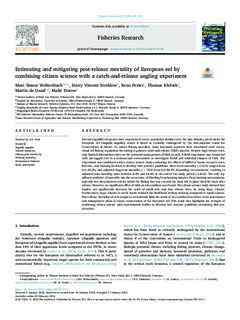| dc.description.abstract | Several anguillid eel species have experienced severe population declines over the past decades, particularly the European eel (Anguilla anguilla), which is listed as critically endangered by the International Union for Conservation of Nature. To reduce fishing mortality, many European countries have introduced strict recreational eel fishing regulations increasing regulatory catch-and-release (C&R) practice. Despite high release rates, only limited information exists on the potential consequences of C&R on eels. A field experiment was conducted with pre-tagged eels in a semi-natural environment to investigate lethal and sublethal impacts of C&R. The experiment was combined with a citizen science study evaluating the effects of different hooks on catch rates, fish size, and hooking location to develop best practice guidelines. Short-term mortality (≤72 h) ranged from 0.0–18.2%, and adjusted long-term mortality (>72 h) from 0.0–46.2% depending on treatments, resulting in adjusted total mortality rates between 8.4% and 64.4% at the end of the study period (≥43 d). The only significant predictor of mortality was the occurrence of bleeding from hooking injuries. Deep hooking was common, and only few deep-hooked eels for which the fishing line was cut and the hook left in place shed the hook after release. However, no significant effect of C&R on eel condition was found. The citizen science study showed that anglers can significantly decrease the catch of small eels, and thus release rates, by using large J-hooks. Furthermore, large J-hooks or circle hooks reduced the likelihood of deep hooking compared to small J-hooks. Post-release mortality of eels caught in recreational fisheries needs to be considered in future stock assessments and management plans to ensure conservation of the European eel. This study also highlights the strength of combining citizen science with experimental studies to develop best practice guidelines promoting fish conservation. | nb_NO |
